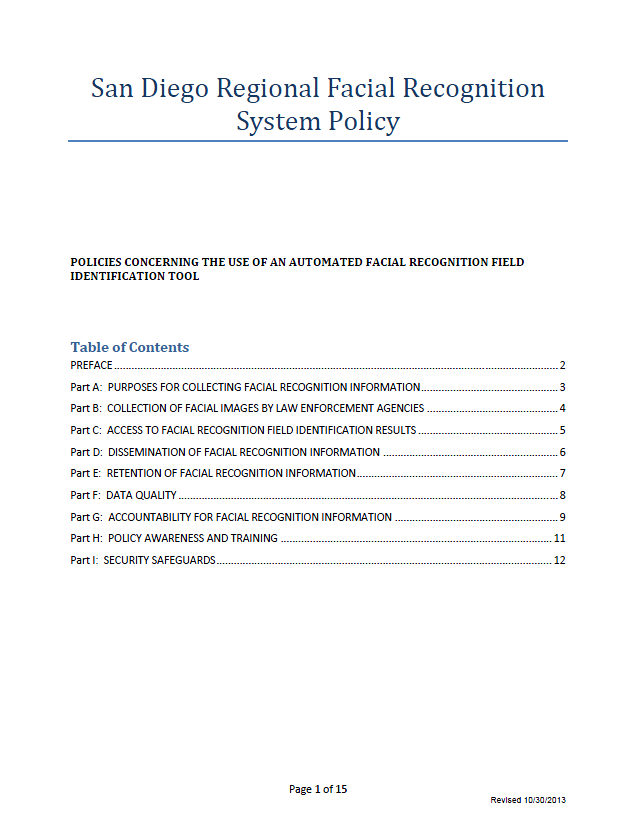The following policy was obtained from the website of the Automated Regional Justice Information System.
POLICIES CONCERNING THE USE OF AN AUTOMATED FACIAL RECOGNITION FIELD IDENTIFICATION TOOL
- 15 pages
- October 30, 2013
These policies are intended to provide law enforcement agencies uniform guidance regarding their appropriate use of a facial recognition field identification tool. Nlets sponsored the preparation of its Privacy Impact Assessment Report for the Utilization of Facial Recognition Technologies to Identify Subjects in the Field to better describe the privacy issues surrounding law enforcement agencies’ utilization of facial recognition technologies in the field. These policies were generated in response to the discussions contained in that report.
The intent of these policies is to:
Address the privacy issues raised by the use of facial recognition systems to identify individuals in public.
The language used in these proposed policies must be assigned its plain and ordinary meaning and individual sections should be implemented in such a way as to give effect to the entire policy. Where two proposed provisions deal with the same subject but one is specific and the other general, the more specific policy provision controls.
…
Part A: PURPOSES FOR COLLECTING FACIAL RECOGNITION INFORMATION
101 Law enforcement agencies collect, compare, and disseminate facial images to aid in the
visual identification of:a) Individuals who come into direct contact with criminal justice practitioners;
b) Individuals who are reasonably suspected of having committed a crime; and
c) Individuals who a law enforcement officer reasonably suspect is about to commit a crime.
102 Law enforcement agencies may request facial recognition comparison information from a criminal justice booking system or other photo repository:
a) To assist an officer in assessing the situation and evaluating any threats to his own safety;
b) To conduct a criminal investigation;
c) To gather information for an intelligence purpose in accordance with 28 C.F.R. Part 23; and
d) To conduct a government security clearance background check.
103 Where appropriate, facial image databases may be accessed to aid in locating a missing person or an individual for whom a warrant has been issued.
Part B: COLLECTION OF FACIAL IMAGES BY LAW ENFORCEMENT AGENCIES
201 Individuals in personal contact with law enforcement officers. Law enforcement officers may collect facial images of individuals with whom they are in personal contact for the purpose of submitting those images to a facial recognition field identification tool in the following circumstances:
a) With the individual’s consent;
b) When identifying the individual will assist the officer in assessing the situation and evaluating any threats to his own safety;
c) When state law requires individuals to identify themselves to police officers;
d) When the individual is lawfully detained and when the suspect’s identity is related to the investigation of the suspicion that originally justified the detention; and
e) When the individual is lawfully detained and using the facial recognition field identification tool does not prolong the detention beyond the time reasonably required to complete the investigation of the suspicion that originally justified the detention.
202 Individuals not in personal contact with law enforcement officers. Law enforcement officers may capture facial images for the purpose of submitting those images to a facial recognition field identification tool in the following circumstances:
a) As part of the investigation of a crime; and
b) As part of an intelligence‐gathering effort that:
i) Is conducted in compliance with the U.S. Department of Justice’s rules and policies governing criminal intelligence systems at 28 C.F.R. Part 23; and
ii) Limits the collection of facial images from areas that reasonably relate to an individual’s political, religious or social views, associations, or activities to instances directly related to criminal conduct or activity.
203 No individual shall be physically detained, nor the individual’s movement otherwise hindered, for the exclusive purpose of collecting their facial image for submission to a facial recognition field identification tool.
Part C: ACCESS TO FACIAL RECOGNITION FIELD IDENTIFICATION RESULTS
301 Law enforcement officers should not request facial recognition field identification results when an individual presents a valid driver license or state identification card unless:
a) The officer reasonably suspects the driver license or identification card is forged, altered, or otherwise fraudulent; or
b) The officer reasonably suspects the individual is presenting, as his or her own, a driver license or identification card issued by a DMV to another person.
302 Where practical, and where it will not negatively impact officer safety, law enforcement officers should first request verification of an individual’s identity through a query of their name, date of birth, and other self‐reported identifiers. When verification is not possible, or if the officer reasonably suspects the self‐reported information is false, officers may request facial recognition field identification results.
303 Where practical, law enforcement officers should submit publicly observable demographic information related to the facial image when requesting facial recognition field identification results.
304 Law enforcement officers shall only access the personally identifying or biographical information of individuals whose facial image is contained in the results of a facial recognition field identification query:
a) After determining that the individual’s enrolled image reasonably matches the facial image submitted for comparison; or
b) When the personally identifying or biographical information would reasonably assist the officer in verifying the identity of the person.

